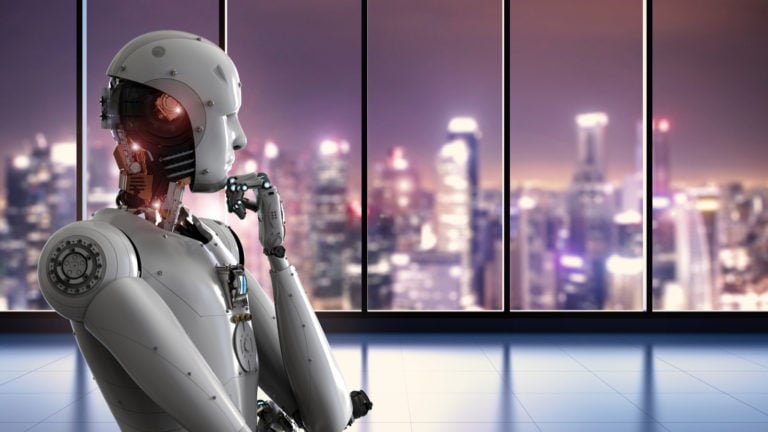On Thursday, we discussed the wonder and terror that can – and has – come with the rise in artificial intelligence and robotics taking on a more prominent role in society.
Of course, what we’re seeing now is nothing new. Every revolutionary technology in history – including steam engines, cars, airplanes, trains, electricity, the internet – has “had the power” to wreck society.
But they didn’t. Think about where we’d be if we didn’t have a mini supercomputer at our fingertips to answer nearly every conceivable question we have. Or a motorized transportation device that reduces what would be an hours-long walk to the office to a mere 20-25 minutes.
Because the truth is, every time a revolutionary new technology is rolled out to the masses, the masses freak out. People worried the speed of train travel would rip the human body apart. They worried radio waves would cause cancer. They believed mechanized weaving looms would cause mass unemployment.
And while AI and robotics may seem massively different than the innovations of the past, they’re not. It just feels different to most people because it’s happening now.
But also as we discussed on Thursday, a dissection of the potential positive outcomes for a new “robotized” future shows how good the future could be…
And there will certainly be profit opportunities – and a lot of them – to come with.
Here’s what I mean…
What Comes Next
The research teams at ABB Robotics and at the International Federation of Robotics have identified a few more factors that could accelerate demand for robots.
A short list would feature…
- Onshoring of manufacturing…
- Artificial intelligence advancements…
- And ease of use.
Let’s go through each of them.
Reshoring
As I’ve pointed out before, onshoring has become the “new-new” thing in corporate America, as companies rush to deglobalize their supply chains and repatriate as much of them as they can.
Previously, the only way to slash production costs was to move production to low-cost manufacturing locales like Mexico and China. But robotics introduces an enticing new possibility.
Some companies can “reshore” production cost-effectively because of the efficiencies robotics produce.
The resulting impact on U.S. jobs is positive, not negative. Companies can shutter production overseas and open facilities in the U.S. using a combination of robotic and human “labor.” In effect, foreign jobs return home to become new jobs for both humans and robots.
Reshoring initiatives in the U.S. created more than 350,000 jobs last year and will add more than 400,000 this year.

Expressed another way, reshoring accounted for 7.6% of net U.S. employment growth last year, and is on track to account for 13% this year. In other words, this stealthy source of employment is becoming increasingly influential in the U.S. economy, and robotics is helping to power it.
The International Federation of Robotics highlights semiconductor manufacturing as one prime example of this trend by observing…
Relocating microchip production back to the US and Europe is another reshoring trend. Since most industrial products nowadays require a semiconductor chip to function, their supply close to the customer is crucial. Robots play a vital role in chip manufacturing, as they live up to the extreme requirements of precision. Specifically designed robots automate the silicon wafer fabrication, take over cleaning and cleansing tasks or test integrated circuits.
Artificial Intelligence
No discussion of robotics would be complete without highlighting the impact of artificial intelligence.
Not all robotic innovations utilize AI, of course; some are merely fancy pre-programmed machines. But AI is playing an increasingly essential role in robotic applications.
Traditional automation performs specific tasks in a rigidly structured process. But AI holds enormous potential for next-level robotics that can operate in variable and unpredictable manufacturing environments.
For example, AI would enable robots to deal with millions of different products that require different processes. AI would also enable robots to distinguish between the objects or people they encounter and respond accordingly.
As ABB Robotics President Marc Segura explains…
As Artificial Intelligence in robotics develops, the concerns around complexity and capability that previously prevented companies from investing in robotic automation, are being addressed. As capabilities develop further, robots will appear in greater numbers and in applications outside of the traditional manufacturing and distribution environments such as electronics, healthcare, e-commerce, pharmaceuticals and food service.
Ease of Use
As robotic systems become increasingly versatile and cost-efficient, demand for them will soar exponentially.
We’ve seen this movie many times. In the 1960s, only massive organizations like NASA could afford to own supercomputers. And only NASA-like organizations possessed the computer wizards who knew how to operate them.
But today, 1.4 billion folks have a NASA-sizedsupercomputer in their back pockets. It’s called an iPhone.
Today’s smart phones are literally “pocket supercomputers” that are spectacularly more powerful than the IBM 360/75 mainframes NASA used to run the Apollo missions throughout the 1960s.
Because smart phones are so convenient and easy to use, their worldwide adoption skyrocketed after the iPhone came to market in 2006.
Ease of use is the key to adoption rates. It always accelerates adoption rates.
AI, combined with autonomous technologies like connected digital networks will make robots easier to operate,enabling them to take on more tasks in new industries.
For example, an industrial robot could be equipped with sensors and software that makes it easy for customers to set up the robots themselves. Once the robots begin operating, combinations of AI and computer vision could also boost its ease of use.
Again from ABB Robotics…
Autonomous technologies continue to make robots easier to program… Developments in artificial intelligence are powering autonomous grasping and positioning, which will expand the range of tasks robots can perform.
At the same time, continued simplification of the software and controllers used to program robots will further reduce barriers to adoption by removing the need for specialist expertise… enabling smaller companies and start-ups to embrace automation.
Welcome to the Golden Age of Robotics. You’ll be glad you’re here.
Regards,
Eric

